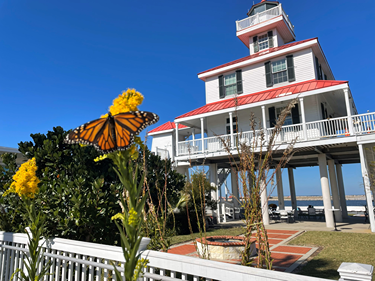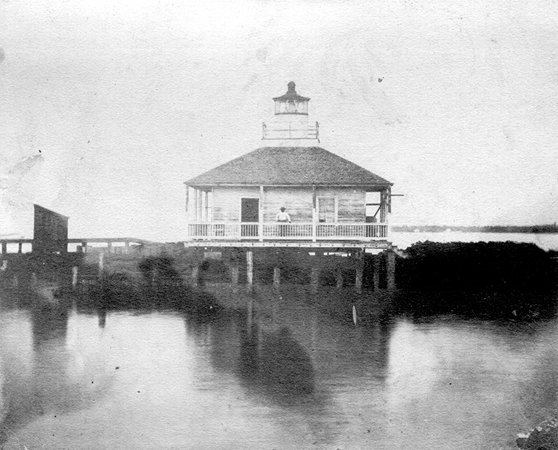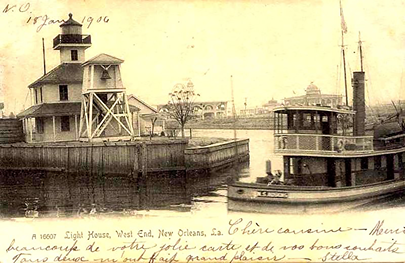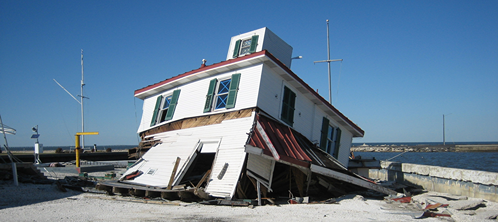Have You Seen the Light?
"And the great ships sail outward and return
Bending and bowing o'er the billowy swells,
And ever joyful, as they see it burn
They wave their silent welcome and farewells."
—The Lighthouse by Henry Wadsworth Longfellow

In either sunny skies or storms, lit up at night or gleaming in the daytime, the New Canal Lighthouse guarding Lake Pontchartrain provides a nostalgic kind of charm and beauty. The candy cane colored structure, proudly standing at the end of Lakeshore Drive, makes for a great photo background and is available for special occasion rentals. With all the nearby family-friendly seafood restaurants, as well as the yacht club situated across the way, it's easy to assume that that's all this lighthouse is—a quaint, pretty tourist attraction. It's so much more than that.
The main level of the New Canal Lighthouse contains a small but fact-packed museum, a bunch of educational activities, and incredible views. The second level houses members of the Pontchartrain Conservancy, who spend their days researching, studying, advocating, planting, and doing outreach. The top of the lighthouse, known as the Lantern Room, is a glass conservatory, situated above a narrow stairway and an even narrower ladder, that protects a working beacon, lighting up as soon as darkness falls every night. Its beams travel nine miles across Lake Pontchartrain, still warning sailors on their way.

The New Canal Lighthouse is the fourth generation of lighthouse built at its location. The first was erected in 1839, strategically placed at the mouth of the New Basin Canal (after which it was named). The lighthouse helped guide sailors safely through the six-mile canal, which took six years to dig and claimed the lives of thousands of builders due to the impossibly difficult working conditions.
In 1855, the original lighthouse, which looked much like the current one without the tall pilings and bottom structure, started sinking and leaning and had to be replaced with something taller and sturdier.
In 1880, the Southern Yacht club was built on the adjacent land mass and, at two stories tall, blocked sailors' view of the lighthouse from several angles. So there was a third lighthouse built even taller in 1890, which stood strong until the devastating double impact of Hurricanes Katrina and Rita.
In the 1960s, five of the six miles of the New Basin Canal were filled by the creation of the I-10. At that point, the lighthouse lost its original, navigational purpose but was still beloved. So with its fourth rebuild, the lighthouse also received a new mission.

The New Canal Lighthouse was designed to be a replica of the initial 1890 structure but updated for current weather conditions and recreated with around 50% of the original materials. Once the Lake Pontchartrain Basin Foundation took over, they prioritized historical accuracy, while keeping an eye on the future of the area. What they built is now a place where anyone who wants can come learn about the beacon's Fresnel lens and how it operates. People can even learn about all the female light keepers who lived there over the centuries, including the most heroic one, Margaret Norvell, and her wild adventures, including rowing through raging storms to rescue drowning people and then housing and feeding them until they got back on their feet.
The lighthouse provides facts about the shifting deltas of the Mississippi River, the development of the lakefront, the way storms have affected and will continue to affect us in the region, and the impact that the conservancy's work has had on the health of the Lake Pontchartrain Basin. You can even interact with a display that shows the food chain of all the common animals surrounding the inlet.
In the gift shop building, located a few yards inland, kids can interact with STEM exhibits, bring water samples to test in beakers for microplastics and algae, and sift through a sandbox that allows you to create 3D models of our coast, illustrating what happens when the water meets the land. You can even build levees, channel rivers, and register your hands as clouds to create storms. Anyone can also take home native flower and herb seeds from their free seed library, with the cyclical hopes that you will bring seeds back once your plants grow. The seeds link to the Pontchartrain Conservancy's larger native plant program, which continues outside with their small greenhouse and bioswale. The bioswale, they explained, contains purifying plants and strategically placed rocks that take trash and gasoline polluted water, driven by the rains from the nearby parking lot, and clean it before it gets down to the canal. This is a wonderful place for school trips and science fairs.

The most surprising offering is their underwater robotics program. On a calm day, weather-wise, and with enough advance warning, you can build your own remote-controlled robot to drop in the canal and get to spy on the underwater activity of the fish and plankton.
It's worth making an appointment to get the full educational tour, especially with Kate Tannian and Dennis Clutter as your generous and playful hosts. This lighthouse has led many lives and the staff and docents are thrilled to share their knowledge and passion for it, as well as information about water quality, coastal environments, and native plant gardening. The staff works throughout the surrounding 16 parishes of the Pontchartrain Basin, conducting scientific investigations, doing coastal restoration, and operating ongoing sustainability projects.
If you want a last-minute adventure, you can also hop on a self-guided audio tour for a small fee and just wander around the exhibits while enjoying the shade and marveling at the history and the view.

